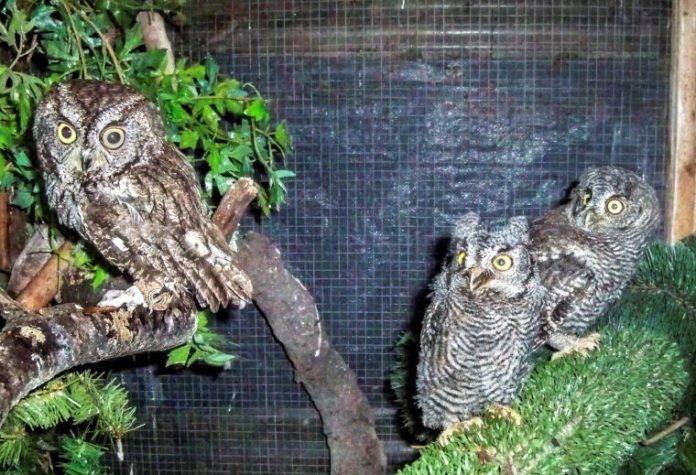“Are you my mother?” the two downy little owlets appear to be asking Owlivia (left). Alas, Owlivia, WERC’s non-releasable educational screech owl, can only be a surrogate to the babies who were orphaned last month and will never see their real mommies again.
The first owlet was very, very weak when it was found on the ground in Gilroy; the second was discovered inside a Morgan Hill resident’s garage, possibly having been brought in by a cat. Fortunately, neither baby had suffered any apparent injuries from their misfortunes. At WERC, the nestlings were immediately warmed up and given hydrating fluids. They quickly recovered their natural spunkiness and were soon eating voraciously the bits of rodents being offered to them.
Within a week, they were eating on their own and it was time to move them into a larger enclosure where they could fledge and learn to fly. This is where Owlivia comes into the picture – as their foster mother, she provides an invaluable aspect to the impressionable youngsters to help them avoid imprinting on the humans that come into the enclosure to feed and clean up.
It’s extremely important for young birds-of-prey to imprint on their own kind. Imprinting is a species-specific type of learning during a critical early period where the bird’s social attachment and identification are established. An imprinted raptor is not releasable; it will not thrive in the wild since other owls recognize its difference and refuse to allow it to establish a territory, which is necessary for hunting and breeding.
The western screech owl does not screech (if you hear that sound at night, it’s likely there’s a barn owl nearby). It’s unclear just why it’s been given that name. One theory is that other birds screech in fright when they see this feisty, aggressive, predatory raptor! The screech owl’s voice is actually a sound that has been likened to a “bouncing ball” – a trilling series of low whistles, sometimes described as ghostly. Because of its appearance, voice, and food preference, the screech owl has been called “little horned owl,” “mouse owl,” “ghost owl” and “cat owl.” (I don’t know how it got the appellation of “cat owl.” My theory is that since the great horned owl, which resembles the screech owl but is much larger, is called a “flying tiger,” the screech owl’s nickname is similarly downsized. For fun, Google “cat owl” to see some comical images of imaginary owls.)
An opportunist hunter, the screech owl eats mostly small rodents, but also includes insects, other birds, crayfish, reptiles and amphibians in its diet. Since the owl is nocturnal (hunting after dusk), it needs to hide from its own predators (Cooper’s hawks, larger owls, weasels, raccoons, skunks, squirrels, snakes and crows) during the daytime and it has evolved a superb method of avoiding detection. When threatened or harassed, the owl stretches its body, tightens its feathers, and extends its feather “horns” in order to look like a small branch. The screech owl is a master of natural camouflage – the colors and patterns of its feathers blend perfectly into the texture and tones of tree bark.
The ability to blend in with their surroundings sometimes also makes it difficult for volunteers to find the three owls in their enclosure as they perch still and quiet. This is Owlivia’s first-time as a foster mom (aka hoot’n’-nanny), and she’s doing a wonderful job “teaching” the owlets to mimic her. Within another couple of months, the owlets will have grown into fully feathered juveniles, able to hunt live food and will be released back near their native habitats where in a few years they will be able to start raising some little owlets of their very own.
In the meantime, Owlivia will return to her regular enclosure for a well-deserved rest.
The Wildlife Education and Rehabilitation Center rehabilitates native wildlife. It is supported solely by donations from businesses and the public. To contact WERC, call (408) 779-9372 or visit www.werc-ca.org.










